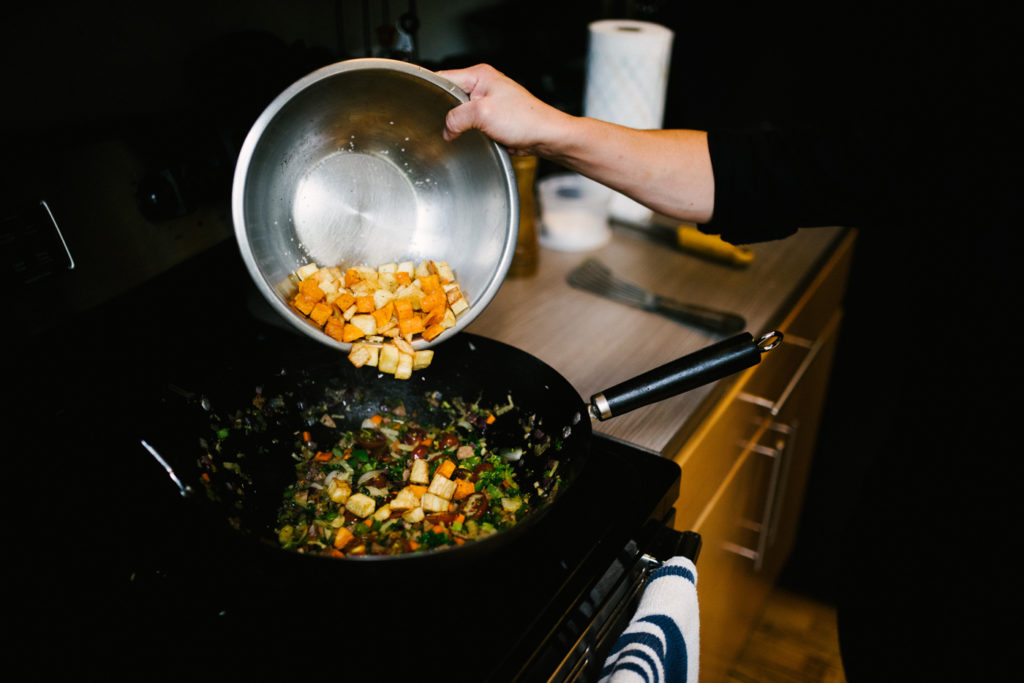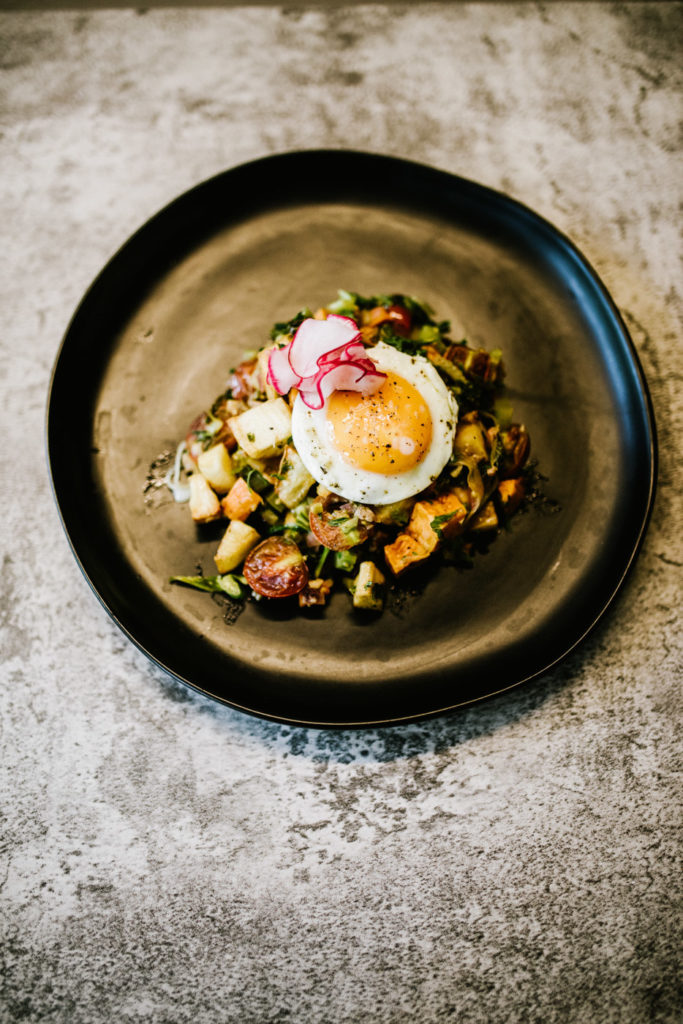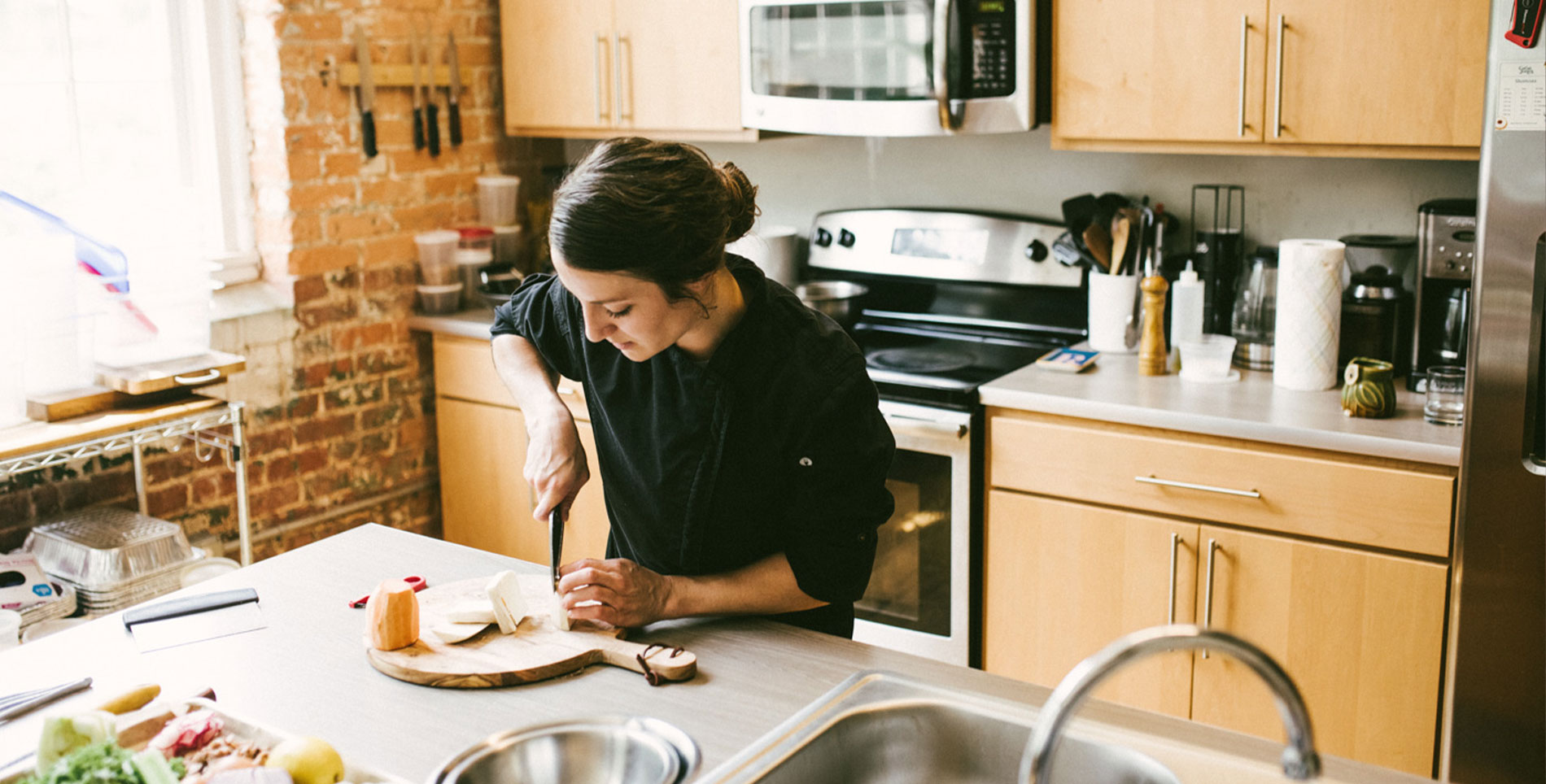Editor’s Note: This story is published in The What We Carry Issue of Life & Thyme Post, our exclusive newspaper for Life & Thyme members. Get your copy.
Working two at a time, Jordan Rainbolt methodically moves finger-length pieces of white cod from a Saran-wrapped tin into the sizzling oil of her skillet, which is large enough to hold all two-dozen servings at once.
It will be the third course of the dinner Rainbolt is serving tonight, but her guests won’t have to wait long; she prepped the fish before they arrived, wrapping it in thinly-shaved sweet potato, and then snugly encasing it in collard greens. Once the fish cooks through, she places it on a biodegradable square plate with a smudge of benne seed paste—which is similar in nuttiness and texture to tahini—and tops the bite with a drizzle of crispy chili oil to give it an edge.
Most of the ingredients, save for maybe the smoked benne paste, are likely familiar to Rainbolt’s diners here in Winston-Salem, a former tobacco town in the heart of North Carolina. By any measure, the collards and sweet potatoes are Southern staples. The white fish comes from Forsyth Seafood Market & Café, a local Black-owned market and restaurant for nearly 40 years, where cod filets are among a range of popular options. In a sense, Rainbolt’s five-course meal tonight is fundamentally Southern, but not in the way most people conceive of it. And that’s part of her motivation.
This is the third Moon Dinner, a monthly series created by Rainbolt, driven by her Indigenous heritage and “inspired by the Cherokee Moon calendar.” After building a career in restaurants in the Kansas City area, South Korea and Charlotte, Rainbolt moved to Winston-Salem and launched a pop-up food business called Native Root. Her flagship dinner series, in particular, allows her to explore a spectrum of Native American culinary traditions and ingredients and connect with her Cherokee and Choctaw lineage.
“From the very beginning of Native Root, I was inspired to get into the history of the Southeast, but using the lens of Native American culture and history—and what we still carry today,” she says. “A lot of people don’t know what the roots of Southern food are.”
North Carolina is home to the largest Native American population in the United States east of the Mississippi River. North Carolina currently recognizes eight tribes. They’re spread across the entire state, including the Waccamaw near Wilmington along the southeastern coast and the Sappony straddling the border with Virginia just north of Raleigh. The two largest in population are the Lumbee Tribe, concentrated along the South Carolina border, and the Eastern Band of Cherokee Indians, headquartered deep in the western mountains near Tennessee.

Yet despite more than roughly 125,000 Native Americans in the state, it’s difficult to find anything labeled as Indigenous food at a public-facing business. The most obvious place to look would arguably be the town of Cherokee. It stands in the heart of tribal territory and is reduced in the eyes of many visitors to a Harrah’s casino, a camping trip stopover, and a main street of touristy stores full of crafts imported from other Native communities across the country, particularly the Southwest.
“When I first moved to North Carolina, I took a trip to Cherokee,” says Rainbolt, who grew up in Kansas but moved to Charlotte in late 2019 to help open a restaurant. “It’s hard to go to even Cherokee and get Native American food. It’s still very scarce.”
Unless you have access to a home-cooked meal, options are limited. Little Princess Restaurant and Hungry Wolf Deli & Fresh Market—which offered some Cherokee food like bean bread—both closed during the pandemic. There’s an annual Cherokee Indian Fair where visitors can try homemade favorites, and Rainbolt plans to go this fall. Yet most of her research is confined to the internet, and the handful of Native American vendors she sources from are out of state.
There are obvious reasons it’s so difficult to find food marketed as Native American. The history of genocide against Indigenous communities in this country can’t be properly condensed to a few sentences, but in North Carolina, that colonial effort ranged from the bloody 1713 Tuscarora War to the enslavement of Native captives to the Trail of Tears. (The Eastern Band of Cherokee actually formed in resistance to this forced westward march.)
In his TEDx Talk titled “Why Aren’t There More Native American Restaurants?” Sioux chef Sean Sherman argues that the answer is also that colonizers intentionally decimated Indigenous food sources like bison. He points out that an involuntary and abusive boarding school system ripped Native children from their families, traditions and ancestral knowledge. “We’re still reeling from that in our communities today,” he says as he paces the stage. “We haven’t had time to heal yet, let alone evolve.”
There’s another reason Native American culinary traditions and ingredients are overlooked in the Southeast—they’ve been claimed as Southern and decontextualized to a point where few acknowledge their origins.
“As I thumb through the elegant layouts in such magazines as Southern Living and Garden & Gun, I see the Indigenous stories that lie beneath recipes portrayed as quintessentially Southern, from cornbread to pecan pie,” author Courtney Lewis writes in her essay “Native Food Sovereignty” in the recently released Edible North Carolina. Elsewhere in the book, Malinda Maynor Lowery also advocates for a more complex view of Southern food. “For me, as a Lumbee, a Southerner, and a North Carolinian, the South is many—not one,” Lowery says.


For Rainbolt, Native Root is an opportunity to explore the interplay of Indigenous and Southern food under the tagline “Indigenous roots of the South,” learning as she goes and sparking conversations through food.
“Once I moved here I realized there’s so much Native American culture here, but you have to dig for it,” Rainbolt says. “One of the most prominent Southern staples that was used in Indigenous cultures is grits.”
But it doesn’t stop there. From livermush to collard greens, Rainbolt aims to illuminate how classic items and dishes owe credit to the area’s original inhabitants. She also uses ingredients that grace few, if any, other food business’ menus across the state, including several that show up on her Moon Dinner menus, such as tonight’s triangular-shaped Native blue corn spoon bread served alongside a thick-cut seared venison steak she seasoned with sumac.
Not everything she cooks is explicitly local or derived from the area’s tribal foodways. Instead, Rainbolt aims to highlight cuisine from across Native America. She sources squash flour from Arizona and uses wild rice that’s long been fundamental to Indigenous diets along Minnesota’s lakes.
“It’s important to take into account that it’s a staple for other tribes,” she says, referring to wild rice. “I want to spend more time highlighting Cherokee, just because of my heritage and background, but covering the whole Indigenous community across the nation is what I focus on.” The clearest example of this may be her Crop Sisters Salad, featured at a previous Moon Dinner. It incorporated squashes, corn and beans—known as the Three Sisters—a trinity of ingredients often planted and consumed together across a plethora of tribes.
Her cooking also reflects other influences on local and regional cuisine, including this dinner’s collard-wrapped white fish. As close to 20 patrons sitting at a line of picnic tables bite into the cod, Rainbolt steps slowly from behind her prep station to describe the course. Her long, brown hair in a loose bun above her black chef’s coat and jeans, Rainbolt matter-of-factly explains that she chose benne seeds to make the accompanying paste because enslaved Africans brought them to the Carolinas and covertly grew them for decades. That’s part of the region’s often omitted history too.
The dinner, held inside the cavernous and industrial Winston Junction Market on the northern rim of downtown, is mostly attended by locals. Swamped by the nearly 100-degree heat washing in from an open garage-style door, the space is home to an axe-throwing venue and a country music and whiskey bar. A band rolls their amps and gear through the grand hall as Rainbolt’s diners chat across a bright blue patterned tablecloth that brings vibrancy to the otherwise drab tabula rasa of the market area.
Rainbolt could easily fit twice as many guests into the building, but she’s still growing her following. She’s relatively new in town, having moved here at the height of the pandemic after The Cheesecake Factory bought out the Charlotte restaurant where she worked.

“I felt unfulfilled,” she says of her former restaurant job. “It was lucrative, but very mundane. I thought, ‘What if I break off and do something that’s important to me?’ I want to be authentic with what I do.”
After making friends in the “City of Arts and Innovation” and trying a couple pop-up cooking events, she relocated. “When I first started, I took a more literal approach. It was a lot more heavy-handed with Native American influence, and that is intimidating to people,” Rainbolt says. Some people balked at certain ingredients or methods she used, such as dandelion greens or serving mountain trout cooked in corn husks.
“I didn’t really get discouraged with it,” she says. “I felt like a mad scientist. At one point I just had different sheets of tracing paper taped on walls throughout my house.”
Now, she offers the Moon Dinner series as explicitly Native, while incorporating cross-cultural influences into menus for more regular pop-ups at various local bars. In March, for example, she sold an “Indi-Bap” rice bowl that played off bibimbap using pork bulgogi and kimchi, but also used Carolina Gold rice, duck egg, sweet potatoes, and oyster and lion’s mane mushrooms. On Cinco de Mayo, Rainbolt was slinging “Indigenous tacos” that included soured sunflower cream and tepary beans served on red corn fry bread.
She enjoys that balance and interplay, describing herself as less of a traditionalist like Sherman—who she considers a major influence—and more akin to Shane Chartrand, who is Cree and takes a more experimental and modern approach to creating dishes, Rainbolt says.
Celebrity chefs like Sherman and Chartrand aren’t alone and are fortunately part of a growing tide of Native chefs, restaurateurs and industry professionals exploring or reclaiming Indigenous foods in North America. Native Root isn’t the only Indigenous-owned food business in the state either, from Handèwa Farms Indigenous farming collective in central North Carolina to Nikki’s Frybread food truck in Cherokee. There are now two Native-owned breweries here—Native American Brewing Co. and 7 Clans Brewing, both in the mountains—and the Lumbee-owned Native Vines Winery, the self-proclaimed “first American Indian owned winery in the country,” is a short drive south from Rainbolt’s Winston-Salem operation.
There are tribal-led efforts to protect Indigenous foodways too, including a garden education program at a new K-12 school opened by the Eastern Band of Cherokee Indians, Lewis writes in Edible North Carolina. Tribal members are also fighting to preserve access to sustainably harvesting wild-grown ramps in Great Smoky Mountains National Park, a centuries-old practice that’s been threatened by outsiders who are mass-foraging ingredients like ramps (wild leeks) for East Coast restaurants, Lewis adds.
It’s all part of a broader push for Indigenous food sovereignty, Sherman says in his TEDx Talk.
“If we can control our food, we can control our future,” he says. “For us, it’s an exciting time to be Indigenous because we are taking all of these lessons from our ancestors that should’ve been passed down to us, relearning them, and utilizing the world today with everything it has to offer and becoming something different.”
Sherman concludes his talk by sharing his hope that someday you’ll be able to drive across the country and “stop at Indigenous-run food businesses” nationwide to experience Indigenous diets defined by “immense plant diversity,” a range of proteins, and regional and seasonal food.
Anyone taking that drive will need to stop here in Winston-Salem, at a nondescript industrial brick building surrounded by craft breweries and an auto-racing museum to try Rainbolt’s pancake-like Bannock bread garnished with smoked maple or crispy rice flour doughnuts with blue corn sugar powder. Her dishes aren’t replicas of what Indigenous communities were eating in the Carolinas hundreds of years ago. Instead, Rainbolt’s inspired creations evoke her heritage and the South while offering a vision for what Southern food could become. In the process of exploring and redefining her own identity, she’s helping the region do the same.
“My mom didn’t cook Indigenous food, but I was taught about her culture and we did learn about her heritage,” Rainbolt says. “It’s nice to circle back around and research it for myself.”
In his talk, Sherman expresses similar sentiment, saying he’s often asked what kinds of foods he grew up with by people who expect him to talk about hunting elk with a bow and arrow, when his reality growing up on a reservation meant reliance on the government’s commodity food program. His Minneapolis restaurant and Rainbolt’s Winston-Salem dinner series both offer diners a chance to challenge their perceptions of Indigenous food and rethink their understanding of local and regional cuisine.
“I think one of the main things I want to be able to take part in and have influence over is provoking thoughtfulness and curiosity of why certain ingredients are being used,” Rainbolt says. “Food is the easiest way to learn about a different culture. For me, that’s very important. I want to set up an opportunity for people to ask questions and learn.”







Our comments section is for members only.
Join today to gain exclusive access.